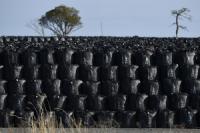-
New technique detects radioactive material even after it is gone
A new technique allows researchers to characterize nuclear material that was in a location even after the nuclear material has been removed – a finding that has significant implications for nuclear nonproliferation and security applications. The technique could identify and characterize a dirty bomb based on samples taken from a room the bomb was in a year ago. “This is a valuable tool for emergency responders, nuclear nonproliferation authorities and forensics, because it allows us to get a rough snapshot of the size of a radiation source, where it was located, how radioactive it is, and what type of radioactive material it is,” a researcher says.
-
-
Scintillating discovery at Sandia Labs
Taking inspiration from an unusual source, a Sandia National Laboratories team has dramatically improved the science of scintillators — objects that detect nuclear threats. According to the team, using organic glass scintillators could soon make it even harder to smuggle nuclear materials through America’s ports and borders. The Sandia Labs team developed a scintillator made of an organic glass which is more effective than the best-known nuclear threat detection material while being much easier and cheaper to produce.
-
-
Amid Texas nuclear waste site's financial woes, judge blocks merger
A federal judge has blocked the purchase of the company that runs Texas’ only nuclear waste dump — a setback in its proposal to accept spent nuclear fuel from across the country. Wednesday’s ruling is the latest setback for a project that the company initially suggested it would start constructing by 2019.
-
-
Possible correlation found between TMI meltdown and thyroid cancers
Three Mile Island (TMI), located near Harrisburg, Pennsylvania, had a partial meltdown accident on 28 March 1979. During the accident, radiation was released into the environment, which the United States Nuclear Regulatory Commission said was in small amounts with no detectable health effects. Penn State College of Medicine researchers have shown, for the first time, a possible correlation between the partial meltdown at TMI and thyroid cancers in the counties surrounding the plant.
-
-
New cracks found in aging Belgian nuclear power plant
More micro-cracks have been discovered at the Belgian Tihange 2 nuclear reactor near the German border. safe. The worries in Germany about radiation leaks from the old reactor are strong. Last year, the government of the German state of North Rhine-Westphalia, which is on the other side of the Belgian-German border, purchased iodine tablets for distribution to the public in the event of radiation leak. Belgium relies on its two 40-year old nuclear reactors for 39 percent of its energy needs, and has extended the operational life of both, even though they were supposed to be decommissioned a decade ago.
-
-
Remote detection of hazardous radioactive substances
Remote detection of radioactive materials is impossible when the measurement location is far from its source. A typical radiation detectors, like Geiger-Muller counters can detect 1 milli Curie (mCi) of Cobalt-60 (60Co) at a maximum distance of 3.5 meters, but are inefficient at measuring lower levels of radioactivity or at longer distances. Researchers have developed a method for the remote detection of hazardous radioactive substances. With the help of this newly developed detection device, the detection of various types of radioactive materials can be done from a remote distance.
-
-
U.S. nuclear watchdog greatly underestimates potential for nuclear disaster

The U.S. Nuclear Regulatory Commission (NRC) relied on faulty analysis to justify its refusal to adopt a critical measure for protecting Americans from the occurrence of a catastrophic nuclear-waste fire at any one of dozens of reactor sites around the country, a new study shows. Fallout from such a fire could be considerably larger than the radioactive emissions from the 2011 Fukushima accident in Japan. These catastrophic consequences, which could be triggered by a large earthquake or a terrorist attack, could be largely avoided by regulatory measures that the NRC refuses to implement.
-
-
Mobile phones can reveal exposure to radiation
In accidents or terror attacks which are suspected to involve radioactive substances, it can be difficult to determine whether people nearby have been exposed to radiation. But by analyzing mobile phones and other objects which come in close contact with the body, it is possible to retrieve important information on radiation exposure.
-
-
New nuclear forensics signature discovery capability to help trace origins of plutonium
Two weeks ago the Department of Homeland Security’s Domestic Nuclear Detection Office (DNDO) joined with partners at the Pacific Northwest National Laboratory (PNNL) to launch the Plutonium Processing Signatures Discovery capability. The new capability, the result of a four-year effort, represents a significant technological advancement in nuclear forensics that will improve our ability to trace the origins of plutonium. Nuclear forensics involves determining where illicit or smuggled radioactive material came from. In the event of a nuclear weapon detonation, knowing where radioactive material came from can help investigators determine who’s responsible.
-
-
“Fishing out” radioactive elements from nuclear waste
Scientists have revealed how arsenic molecules might be used to “fish out” the most toxic elements from radioactive nuclear waste — a breakthrough that could make the decommissioning industry even safer and more effective. “Nuclear power could potentially produce far less carbon dioxide than fossil fuels, but the long-lived waste it produces is radioactive and needs to be handled appropriately,” one scientists said.
-
-
Detecting weapons-grade uranium from afar
It is hard enough to identify nuclear materials when you can directly scan a suspicious suitcase or shipping container. But if you cannot get close? A technique for detecting enriched uranium with lasers could help regulators sniff out illicit nuclear activities from as far as a couple of miles away.
-
-
Radiation threat detection system successfully tested in Washington, D.C.
DARPA’s SIGMA program — whose goal is to prevent attacks involving radiological “dirty bombs” and other nuclear threats — concluded its biggest and longest test deployment of vehicle-mounted radiation detectors in Washington, D.C., in February. For approximately seven months starting in July 2016, the fleet of D.C. Fire and Emergency Medical Services ambulances was outfitted with DARPA-developed nuclear and radiological detectors, providing the first city-scale, dynamic, real-time map of background radiation levels throughout the Capital as well as identifying any unusual spikes that could indicate a threat.
-
-
Preventing nuclear waste seepage
Nuclear waste is a reality, whether remnants of nuclear weapons or the byproducts of nuclear power plants. While we aren’t at risk of an attack from a giant radioactive lizard, nuclear waste can still pose threats to human health. The best way to safely store and contain nuclear waste is by mixing it into a cement grout and storing it in large concrete vaults. Researchers are testing the permeability of these grout mixtures and in turn, the ability for nuclear materials to eventually flow through the solidified grout and into the environment.
-
-
System automatically detects cracks in steel components of nuclear power plants
The United States operates 99 commercial nuclear power plants, which account for about 20 percent of total U.S. electricity generation. Aging can result in cracking, fatigue, embrittlement of metal components, wear, erosion, corrosion and oxidation. Researchers have developed a new automated system which detects cracks in the steel components of nuclear power plants and has been shown to be more accurate than other automated systems.
-
-
NY’s Indian Point nuclear plant to close after many “safety events”

New York’s Indian Point nuclear power plant will close by April 2021, Governor Andrew Cuomo said on Monday. “For fifteen years, I have been deeply concerned by the continuing safety violations at Indian Point, especially given its location in the largest and most densely populated metropolitan region in the country,” Cuomo said. “I am proud to have secured this agreement with Entergy [the plant’s operator] to responsibly close the facility fourteen years ahead of schedule, to protect the safety of all New Yorkers.”
-
- All
- Regional
- Water
- Biometrics
- Borders/Immig
- Business
- Cybersecurity
- Detection
- Disasters
- Government
- Infrastructure
- International
- Public health
- Public Safety
- Communication interoperabillity
- Emergency services
- Emergency medical services
- Fire
- First response
- IEDs
- Law Enforcement
- Law Enforcement Technology
- Military technology
- Nonlethal weapons
- Nuclear weapons
- Personal protection equipment
- Police
- Notification /alert systems
- Situational awareness
- Weapons systems
- Sci-Tech
- Sector Reports
- Surveillance
- Transportation
Advertising & Marketing: advertise@newswirepubs.com
Editorial: editor@newswirepubs.com
General: info@newswirepubs.com
2010-2011 © News Wire Publications, LLC News Wire Publications, LLC
220 Old Country Road | Suite 200 | Mineola | New York | 11501
Permissions and Policies
Editorial: editor@newswirepubs.com
General: info@newswirepubs.com
2010-2011 © News Wire Publications, LLC News Wire Publications, LLC
220 Old Country Road | Suite 200 | Mineola | New York | 11501
Permissions and Policies
